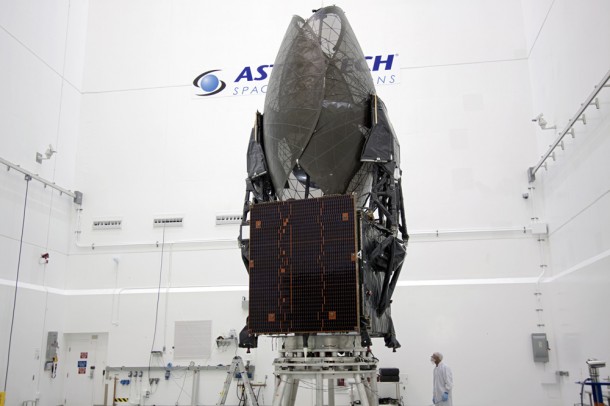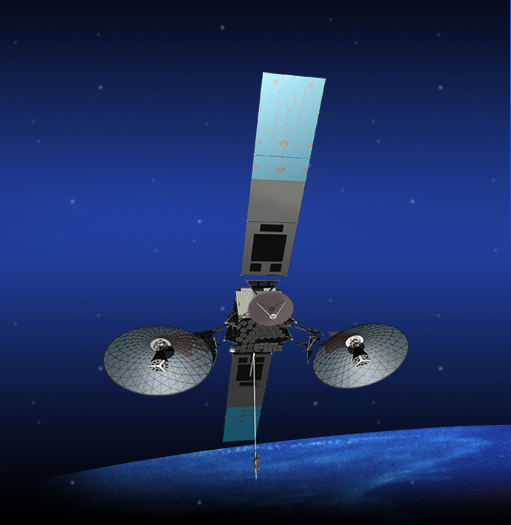NASA?s Tracking and Data Relay Satellite System will get an upgrade this month when the agency launches the first of a new generation of communications satellites to connect spacecraft to the ground stations that support them.
A United Launch Alliance Atlas V 401 is due to loft the TDRS-K spacecraft Jan. 29 on a course to geosynchronous orbit where the spacecraft will have a wide view of Earth. From that position, the spacecraft will pick up signals from NASA?s fleet of Earth-orbiting science spacecraft, including the International Space Station and NASA?s Hubble Space Telescope, and relay them to ground stations.

The TDRS-K spacecraft stands inside a processing hangar in Titusville, Fla., awaiting packaging for launch into orbit 22,300 miles above Earth. Photo credit: NASA/Jim Grossmann
The advanced spacecraft, also known as TDRSS for the whole system or TDRS for an individual spacecraft and its greater capacity is needed to keep the communications network on pace as NASA?s fleet of research satellites has increased.
?It has some higher bandwidth speeds,? said Diana Calero, mission manager for NASA?s Launch Services Program, or LSP, based at Kennedy Space Center in Florida. ?We have some aging satellites, so we need some new spacecraft to go in there and carry some more of the bandwidth.?
The processing for this mission included the standard in-depth reviews but also took into account extra engineering sessions to investigate whether the underperformance of an upper stage engine during an earlier, non-NASA launch would occur during the TDRS ascent, said Tim Dunn, NASA launch director. The Centaur upper stage used by the Atlas V uses an engine similar to the one that underperformed during a Delta IV launch last year.

An artist concept of the TDRS-K spacecraft in orbit with its assortment of antennas and a pair of solar arrays to provide electricity. Credit: The Boeing Co.
?Our engineers and analysts from the Launch Services Program, working alongside the United Launch Alliance engineers, we?ve been methodically reviewing data and working very closely on flight clearance for the TDRS-K mission, so that?s been our biggest challenge to date,? Dunn said.
The new TDRS took on the look of a fly as it stood with its large steerable antennas folded over top of each other inside a processing hangar at Astrotech in Titusville, Fla. The spacecraft, built by The Boeing Company in El Segundo, Calif., arrived in Florida just before the holiday break. Following testing and launch preparations, it was packed inside a two-part payload fairing and taken to Space Launch Complex 41 at Cape Canaveral Air Force Station.
It will take about half an hour for the spacecraft to unfold its two circular antennas and a pair of large solar arrays as it climbs to its destination. Onboard thrusters will provide the final guidance for the spacecraft as it settles into its operational location.
?The antennas are furled and they have a margin, a certain amount of days that they can stay furled,? Calero said. ?If they pass that margin, then the antennas, when they?re deployed, they can actually have a degradation in space and so we have to play close attention to how long that stays furled. So it was really challenging trying to schedule the shipping of the spacecraft with the launch date. We?re still watching it very closely.?
TDRS-K will be the 11th TDRS launched by NASA since it began building the space-borne network in 1983. The most recent spacecraft launched in 2002.
?We haven?t launched a TDRS in about 10 years so it?s really good to have this,? Calero said.
The new TDRS will be able to transmit several times more information than its predecessors.
?In terms of bandwidth capability, it?s probably four or five times higher bandwidth improvement,? said Paul Buchanan, deputy project manager for TDRS.
Orbiting about 22,300 miles above Earth, positioned roughly over Hawaii, TDRS-K will put a myriad of antennas to work to receive and transmit signals from a wide range of spacecraft to Earth and vice-versa.
The satellites are not much different from those used by companies such as DirecTV, Buchanan said.
?Ours is more science and data and voice versus radio and television, but it?s essentially the same type of technology, it?s just implemented differently,? Buchanan said.
Even rockets carrying NASA spacecraft carry TDRS-compatible communications gear and transmit telemetry through the orbiting network instead of ground stations, an advancement that saves NASA money by not having to field specialized aircraft and ships or open a string of remote stations to monitor a launch.
The number of satellites required to serve NASA?s orbiting fleet of scientific spacecraft has grown to such an extent that the TDRS network already operating in orbit plus the TDRS-K and two identical TDRS spacecraft launching next year and in 2015 will have plenty of commands, telemetry and data to relay.
?All the Hubble pictures come through TDRS, all the video that we see from the space station and the astronauts and the video we saw from the shuttle, it all comes through TDRS, and then we have all the Earth-orbiting satellites, all that data comes through TDRS,? Buchanan said.
The communications constellation replaced the ground stations positioned on Earth so NASA could communicate with astronauts in orbit. That system allowed contact only when the spacecraft passed within range of the antennas, however. With TDRS satellites in place, controllers have near-constant contact with spacecraft.
?If you roll back in history maybe 30, 40 years, back in Mercury days and Apollo there were no TDRS satellites for communication so you had outages between the ground stations,? Buchanan said. ?We didn?t want the outages, we wanted continuous (communications), so that?s what prompted the TDRS.?
Six TDRS spacecraft are operational in orbit, one new satellite is in orbital storage ready to take the place of an older TDRS and two older models have been retired. The oldest one still working is TDRS-3, launched in September 1988 aboard the space shuttle Discovery.
?We?ve had to decommission two legacy spacecraft in the last year or two due to the fact that electronics start to die after 20, 25 years,? Buchanan said. ?We?re launching now for an immediate need and replenishment schedule. I think it?s a fine balance between the existing system and replenishment.?
When their service life is up, the TDRS satellites are moved farther from Earth into what?s called a storage orbit about 250 miles higher.
Source: http://spacefellowship.com/news/art31826/tdrs-k-offers-upgrade-to-vital-communications-net.html
memorial day ivan rodriguez planetary resources mothers day gift ideas natalee holloway scotty mccreery megan fox pregnant
No comments:
Post a Comment
Note: Only a member of this blog may post a comment.